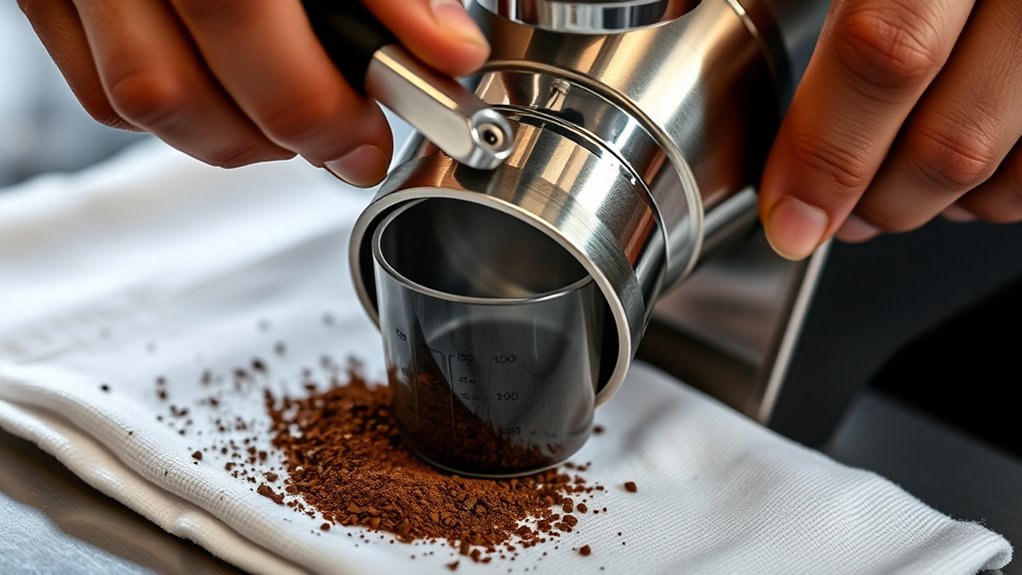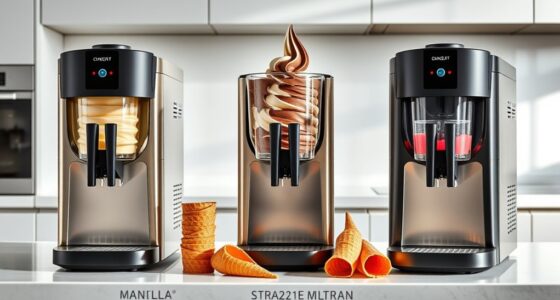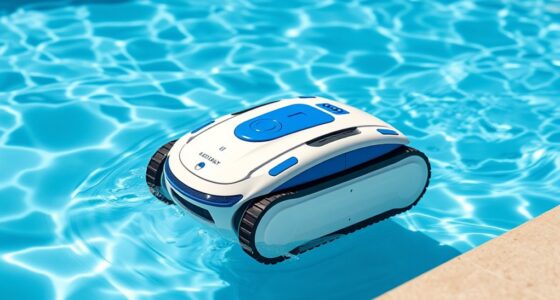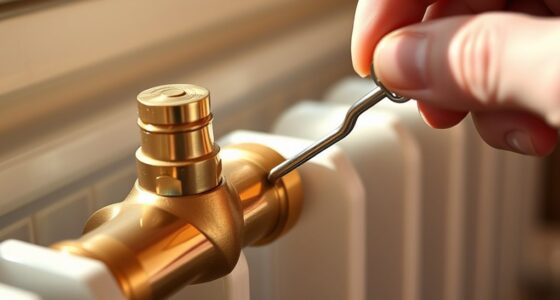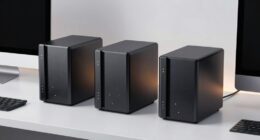To measure your coffee grinder’s cleanliness, start with a visual check for residue, oils, and buildup on burrs and chamber. Perform a smell test with fresh beans to detect lingering odors. Check grind consistency for clumps or uneven particles, and run a zero-residual test with fresh coffee. Use a magnet to spot metal shavings and track changes in grind size and flavor over time. Keeping a cleaning log helps you know when it’s time for the next cycle—if you continue, you’ll discover even more expert tips.
Key Takeaways
- Conduct visual inspections for residue, oils, and buildup on burrs and chamber after cleaning.
- Use smell tests with fresh beans to detect lingering odors indicating incomplete cleaning.
- Run a zero-residual test by brewing with fresh coffee to check for off-flavors or residual oils.
- Measure grind consistency and uniformity before and after cleaning to assess performance improvements.
- Observe noise levels, vibration, and motor temperature during operation to evaluate cleaning effectiveness.
Visual Inspection of Residue and Coffee Oils

Have you ever wondered what residue and coffee oils look like after grinding? When you perform a visual inspection, you’ll notice dark, greasy patches on the burrs and the inside chamber. These buildup signs indicate it’s time to clean. Regularly checking your grinder helps you stick to a maintenance schedule, preventing stale oils from affecting flavor. Use cleaning tools like brushes or cloths to spot residue and oils clinging to the grinding components. If you see a thick film or stubborn oily spots, it’s a clear sign you need to clean. Incorporating this step into your routine guarantees your grinder stays in top shape, preserves coffee quality, and keeps your maintenance schedule on track. Visual cues are your first line of defense against flavor contamination. Proper maintenance is essential for ensuring optimal coffee flavor and extending the lifespan of your grinder.
Smell Test for Lingering Odors
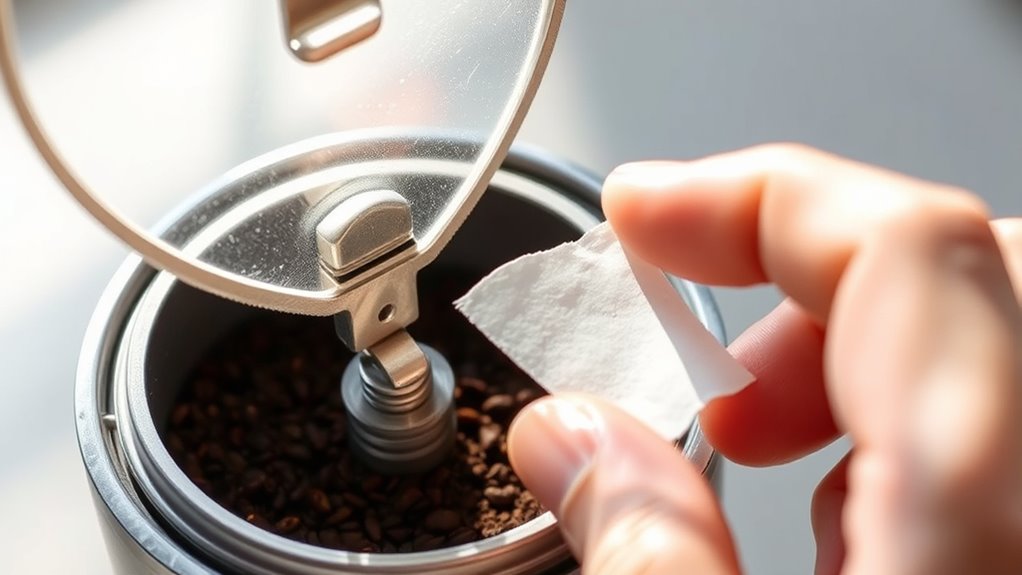
A simple yet effective way to detect lingering odors in your coffee grinder is to perform a smell test. This method helps with odor detection by revealing any residual scent that might affect future brews. To do this, run a small batch of fresh coffee beans through the grinder, then smell the grounds immediately afterward. If strong or unusual scents persist, it indicates scent longevity that could impact the flavor of your coffee. If you notice odors lingering, it’s a sign to clean your grinder thoroughly. Regular smell tests help ensure your grinder is free of unwanted odors, maintaining the freshness of your coffee. This simple step keeps your grinder odor-free and ensures every cup tastes just right. Additionally, understanding the importance of proper cleaning can prevent ineffective purification and improve the overall quality of your coffee.
Checking Grind Consistency and Uniformity

To guarantee your coffee grinder is working properly, start by visually inspecting the ground coffee for consistency. Look for uniform particle sizes and check for any clumps or uneven areas. Maintaining consistent grind size is key to achieving a balanced brew every time. Additionally, paying attention to the coffee grinder maintenance routine can help preserve optimal performance and consistent results.
Visual Inspection Techniques
Visual inspection is an essential step for evaluating how well your coffee grinder is cleaning itself. Start by checking for dust accumulation around the burrs and grind chamber, which indicates leftover debris. Look for any buildup that could affect performance or taste. Next, listen for unusual motor noise during operation; increased or irregular noise can signal residual particles or a need for cleaning. Observe the grind path for clumps or inconsistent particle sizes, which suggest uneven cleaning. Examine the interior surfaces and burrs for dark residue or oily spots, both signs of residual coffee oils and grounds. Regularly performing these visual checks helps you identify areas needing a deeper clean, ensuring your grinder maintains optimal performance and avoids cross-contamination. Additionally, understanding resources and tools available for maintenance can improve your cleaning routine and prolong your equipment’s lifespan.
Consistency in Grind Size
Checking grind consistency is crucial for ensuring your coffee grinder produces uniform particles, which directly impacts the flavor and extraction. To assess this, examine the grind particle distribution—are the particles similar in size, or are there many coarse and fine fragments? Consistent grind size indicates good burr alignment accuracy, meaning your burrs are properly aligned, ensuring even particle size. If the particles vary widely, it’s a sign your grinder needs adjustment or cleaning. You can test this by inspecting the grounds visually or using a sieve to separate and measure particle sizes. Regularly checking the grind consistency helps you maintain ideal extraction and flavor. Proper burr alignment and uniform grind particle distribution are essential for a balanced, high-quality brew. burr alignment accuracy is a key factor in achieving consistent grind size and optimal coffee flavor.
Performing a Zero-Residual Test With Fresh Coffee
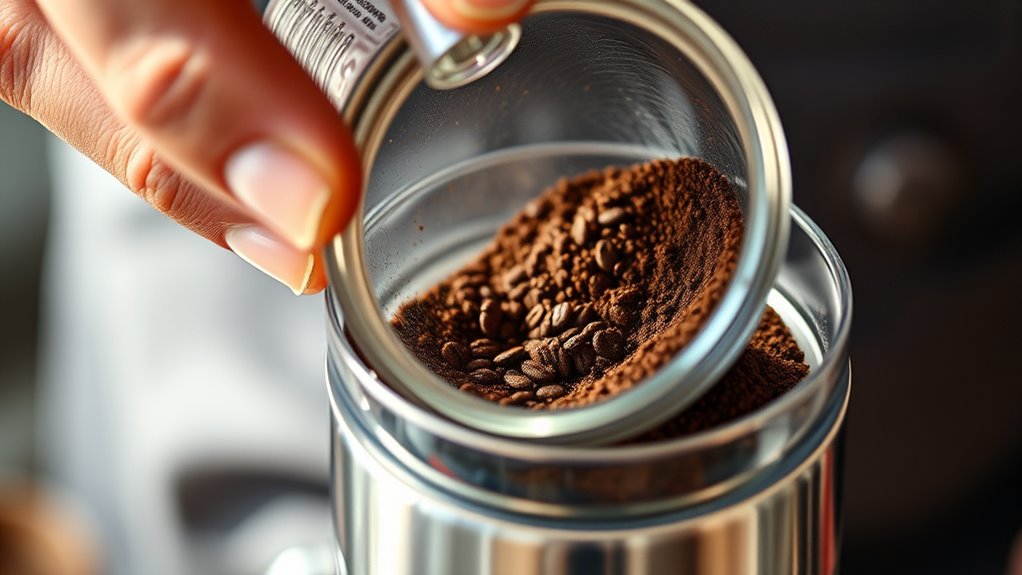
Start by selecting fresh, high-quality coffee to guarantee accurate test results. Prepare your brew carefully, following your usual process to avoid introducing variables. With your fresh coffee ready, you can perform the zero-residual test to confirm your grinder is thoroughly clean. Incorporating mindful relaxation techniques during the process can help maintain focus and ensure thorough cleaning.
Fresh Coffee Selection
Have you ever wondered whether your coffee grinder is completely clean before brewing? Using fresh coffee for a zero-residual test helps you find out. When you grind fresh beans, the coffee aroma is at its peak, making any leftover residue easier to detect. If you notice a stale or off smell, it indicates residual coffee or oils from previous grinds. Bean freshness plays a key role; fresh beans release vibrant aromas, revealing even tiny bits of old coffee. Confirm your grinder is thoroughly cleaned before testing by running fresh beans through it. This way, any residual flavors or oils are minimized, giving you a more accurate assessment of your cleaning process. A clean grinder preserves the true flavor of your coffee, highlighting the importance of proper maintenance. Additionally, understanding the role of cleanliness in flavor quality underscores how crucial regular cleaning is for optimal brewing results.
Proper Brew Preparation
After guaranteeing your grinder is spotless, the next step is to prepare your brew in a way that accurately reveals any lingering residues. Use fresh coffee and grind a small amount, paying attention to the grinder noise—any unusual sounds may indicate residual build-up. Brew your coffee as you normally would and focus on the coffee aroma; a clean grinder produces a clear, vibrant scent, while residual oils can dull or alter it. Tasting the brew helps confirm cleanliness—if it tastes off or stale, residues might still be present. This zero-residual test ensures your grinder is thoroughly clean, so future brews will have ideal flavor and aroma. Regularly conducting cleaning assessments helps maintain your grinder’s performance and the quality of your coffee.
Using a Magnet for Metal Particle Detection

Using a magnet is an effective way to detect and remove metal particles from your coffee grinder. Metal fragment detection is vital for preventing damage to your grinder and guaranteeing safety. Magnetic cleaning tools help you quickly identify hidden metal shavings that might be missed during visual inspection. To use a magnet effectively:
- Run the magnet along the grinder’s burrs and chamber.
- Check for any attracted metal shavings or fragments.
- Use a strong, flexible magnet for thorough coverage.
- Periodically test with the magnet after cleaning.
- Combine with other cleaning methods for best results.
This technique ensures you catch stray metal pieces early, avoiding potential damage or contamination. Regular use of magnetic cleaning tools enhances your grinder’s longevity and maintains the quality of your coffee. Metal fragment detection has never been easier or more reliable. Incorporating proper maintenance techniques into your routine is essential for preserving your grinder’s performance and ensuring safe coffee brewing.
Measuring Grind Size Variability Over Time
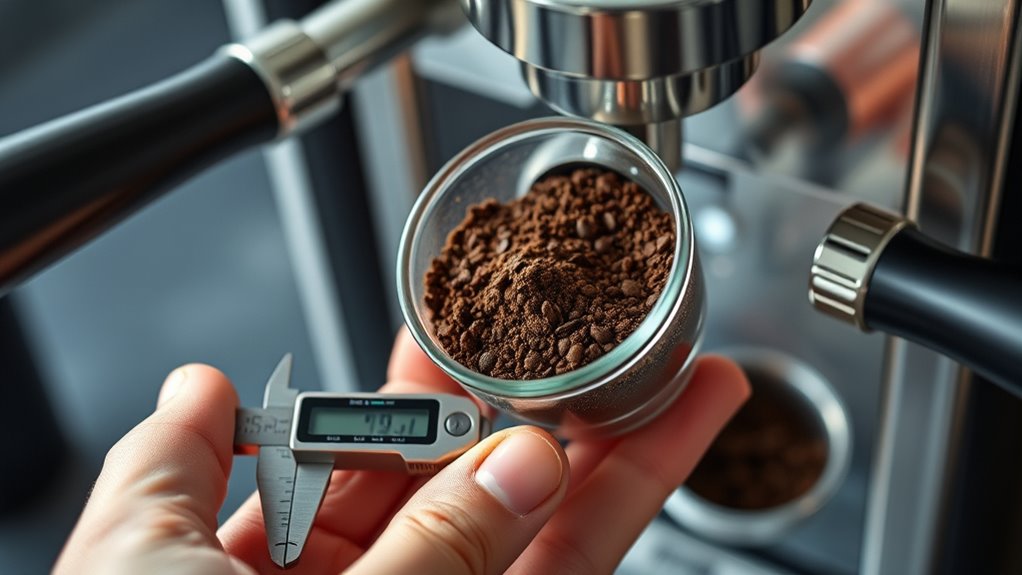
Monitoring grind size variability over time is essential for maintaining consistent coffee quality. Regularly checking grind size helps identify fluctuations that affect flavor and extraction. To track this, measure your grind size periodically and record the results. Use residue buildup analysis to spot clogs or inconsistencies caused by leftover particles. Here’s a simple way to organize your data:
| Date | Grind Size (mm) | Residue Buildup Notes |
|---|---|---|
| 2024-04-01 | 0.30 | Minimal, clean burrs |
| 2024-04-08 | 0.35 | Slight residue buildup |
| 2024-04-15 | 0.40 | Noticeable buildup |
This table helps you visualize grind consistency changes over time, ensuring your grinder stays clean and performs ideal. Recognizing grind size variability is crucial for optimizing your brewing process.
Monitoring Brew Flavor Changes Over Multiple Uses

Tracking how brew flavor evolves over multiple uses allows you to identify subtle changes that may affect your coffee experience. By paying attention to flavor shifts, you can determine if your grinder’s motor health is declining or if inconsistent user cleaning habits are causing buildup. Monitoring these changes helps you decide when to clean or service your grinder, maintaining peak performance.
Consider these tips:
- Note flavor differences after each use
- Keep a record of your cleaning schedule
- Observe if flavors become dull or off-taste
- Check for inconsistent grind quality
- Stay alert to any increased noise or resistance during grinding
This approach ensures you catch early signs of wear or contamination, preserving your coffee’s freshness and your grinder’s longevity.
Conducting a Cleaning Frequency Log

Starting a cleaning frequency log is an effective way to keep your coffee grinder in top shape. By tracking when you clean, you can identify patterns that impact grinder calibration and consistency. Record details like the type of beans used, grind size, and cleaning date. Incorporate noise level analysis by noting any changes in the grinder’s sound, which can signal buildup or wear. Regular logs help you determine ideal cleaning intervals, preventing stale grounds from affecting flavor or causing calibration issues. Over time, this data reveals when your grinder needs attention, ensuring consistent performance. Keeping detailed records allows you to maintain peak grinding efficiency while reducing unnecessary cleaning cycles. Ultimately, a cleaning frequency log becomes your personalized tool for prolonging your grinder’s lifespan.
Assessing Grinder Performance After Cleaning Cycles

After completing a cleaning cycle, it’s important to assess how well your grinder is performing. Pay attention to grinder noise levels—if it’s louder or smoother than usual, cleaning may have improved performance. Check the motor temperature; a cooler motor indicates less strain and effective cleaning. To evaluate, consider these points:
Assess grinder performance after cleaning by listening for smoother operation and checking motor temperature.
- Listen for any unusual grinder noise levels during operation
- Feel the motor for excessive heat after grinding
- Observe consistency in grind size and uniformity
- Monitor the time it takes to grind a standard amount
- Assess the overall noise and vibration for signs of smoother operation
These checks help you determine if your cleaning was successful and if your grinder is functioning ideal
Frequently Asked Questions
How Often Should I Calibrate My Grinder for Optimal Cleaning?
You should calibrate your grinder every 2-4 weeks to maintain ideal cleaning. Regular grinder calibration helps you accurately measure residue buildup and ensures consistent grind size. If you notice uneven extraction or flavor changes, it’s a sign to calibrate sooner. By staying on top of residue measurement through calibration, you keep your grinder clean and your coffee tasting its best. Consistent calibration is key to ongoing coffee quality.
Can Cleaning Methods Damage the Grinder’s Burrs or Blades?
Cleaning techniques can sometimes damage your grinder’s burrs or blades if you’re too harsh or use abrasive materials. To safeguard grinder durability, avoid metal scrapers or harsh chemicals, and opt for gentle brushes and soft cloths. Regular, careful cleaning prevents buildup without harming components. Proper maintenance ensures your grinder stays in great shape, extending its lifespan and maintaining consistent coffee grounds for ideal brewing.
What Tools Are Best for Measuring Residue Levels Accurately?
Think of residue detection tools as your coffee grinder’s microscope, revealing hidden dirt. To measure residue levels accurately, you should use a digital microscope or a portable spectrometer. These tools offer precise measurement accuracy, helping you identify even tiny residues. By choosing the right device, you guarantee your grinder stays clean and safe, preventing flavor contamination and maintaining peak performance. Trust these tools to give you a clear, detailed view of residue buildup.
Is It Necessary to Disassemble the Grinder for Thorough Cleaning?
No, you don’t always need to disassemble your grinder for thorough cleaning. Regular grinder maintenance often involves cleaning accessible parts and residue analysis to spot buildup. However, for a deep clean and to remove stubborn residue, disassembly becomes necessary. Carefully follow your manufacturer’s instructions to avoid damage, ensuring you can effectively maintain your grinder’s performance and keep residue levels in check.
How Can I Tell if Cleaning Has Improved Coffee Extraction Quality?
You’ll notice improved coffee extraction when your brewed coffee flows smoothly, with richer aroma and balanced flavor. To tell if cleaning has helped, observe grind consistency—more uniform particles mean better sensor calibration. If your coffee’s taste becomes more vibrant and the extraction process feels easier, it’s a clear sign your grinder’s cleanliness enhances performance. Keep an eye on these cues to make certain your cleaning efforts truly pay off.
Conclusion
By regularly measuring your coffee grinder, you’re tuning it like a fine instrument, ensuring each brew sings with clarity. Keep an eye on residue, odors, and grind consistency, and you’ll catch issues before they brew into problems. With consistent checks, your grinder becomes a trusted partner, delivering that perfect cup every time. Remember, a well-maintained grinder is the secret ingredient to coffee that truly awakens your senses.
